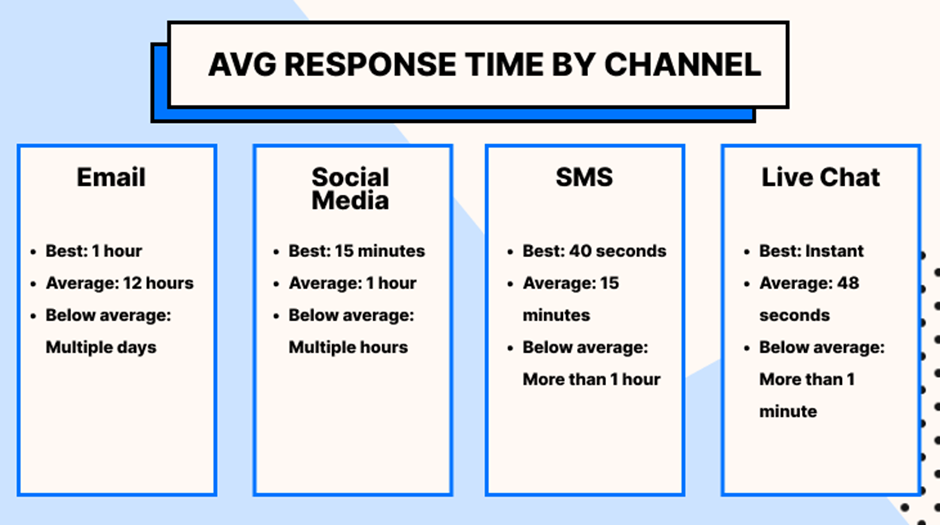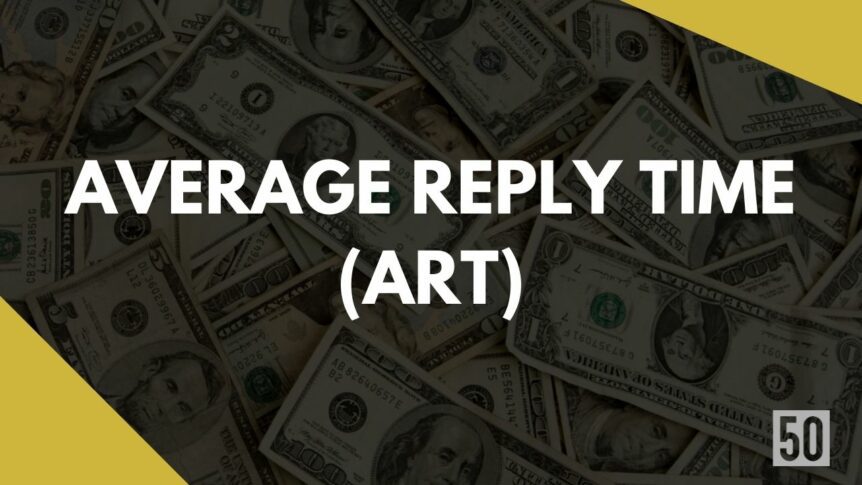If you’re running a customer service operation of any kind, it’s important to track your average reply time (ART). This metric will help you evaluate the performance of your team and identify areas where you can improve. In this article, we’ll show you how to calculate ART and provide some tips for reducing response times. Let’s get started!
What is the Average Reply Time (ART)?
ART is a key metric for support teams. It helps them understand how long, on average, it takes them to reply to a customer.
Unlike First Response Time, ART includes any time a customer has to wait for a reply. This is important because it gives you a more accurate picture of the customer experience. It also allows you to compare your performance against other support teams.
As a general rule, the shorter the Average Reply Time, the better. This means that customers are not having to wait long for a response. Of course, there are always exceptions to this rule. For example, if you are providing support for a complex product, it is likely that your Average Reply Time will be longer than for a simple product. In these cases, it is more important to focus on ensuring that customers are getting the help they need, rather than on reducing your Average Reply Time.
Why Is It Important For Startups To Track This Metric?
Starting a successful business requires effective and efficient communication between teams, customers, and partners. Tracking the average reply time of customer inquiries allows startups to be proactive in their approach and significantly improve their customer service experience.
Research shows that 71% of customers base their decisions on the quality of their experience with a company. If a customer does not get a quick answer to their query, they are likely to abandon the purchase altogether – this is evidenced by Forrester’s data, which indicates that 55% of customers will do so. This highlights the importance of achieving a low average reply time in order to ensure customer satisfaction and keep conversion rates high.
Staying on top of average reply times also helps businesses monitor the performance of their customer service teams and make sure that any issues or concerns are dealt with quickly and promptly. It’s essential for startups to stay informed about an important metric such as the average reply time since it reflects positively (or negatively) directly on customer experiences and plays an essential role in upholding the reputation of a business.
How do you calculate Average Reply Time (ART)?
Here is the formula:
Total customer time spent waiting for a reply / No. of customer messages needing a reply = Average Reply Time
Calculating the Average Reply Time can not only help you assess how responsive your customer service team is but it can also help identify areas for improvement. A good customer experience should be fast and efficient, so taking the time to calculate this metric will ensure that customers don’t have to wait too long for a response.
It’s easy to calculate – just add up all the times taken for replies and divide them by the number of messages sent. However, it’s important to note that automated responses shouldn’t be included in the calculations.
The Average Reply Time (ART) can be measured in different ways depending on the needs of the customer service team. A common approach is to not count time outside of normal business hours, such as if a customer emails at 11:00 pm on a Sunday and isn’t replied to until 10:00 am Monday morning. In this case, the reply time is considered to be 1 hour instead of the 10 hours it actually took.
However, measuring Average Reply Time as a customer experiences it (including all hours) can help justify expanding support coverage to more time zones or even the weekend. This provides customers with better service and helps ensure that their inquiries are being addressed quickly and efficiently.
What factors affect Average Reply Time (ART)?
Here are the factors that affect average reply time (ART):
Quality of service
The quality of customer service is a major factor affecting the average reply time. Customers expect a timely response to their inquiries and having good customer service will ensure that they get their answers in a timely manner.
Size of team
The size of the customer support team also affects ART. If there are few people working on customer queries, it will take longer to answer all of them. On the other hand, having more staff dedicated to responding to customers can reduce ART significantly.
Automation
Automating certain processes and using AI-powered chatbot technology can help drastically reduce response times. AI-powered chatbot technology can respond to customer inquiries quickly and accurately, reducing average reply time.
Communication channels
The number of communication channels used also affects ART. If a company offers multiple ways for customers to get in touch with them, such as email, phone, chat, etc., then it will take less time to respond to queries since they can be answered on multiple channels simultaneously.
Response time target
If a company sets response time targets, it will help motivate customer service reps to respond quickly and reduce average reply time. Setting clear time frames and expectations can encourage customer service reps to prioritize responses in order to meet their goals.
Availability of resources
Having sufficient resources available is another major factor that affects ART. For example, if customer service reps don’t have access to the necessary information or tools to answer queries quickly and accurately, then it will take longer for them to respond.
All of these factors can have a major impact on average reply time and should be taken into account when setting up customer service protocols. By understanding these factors and implementing the necessary changes, companies can significantly reduce their ART and improve customer satisfaction.
What is a good Average Reply Time (ART)?
When it comes to customer service, customers appreciate responsiveness. That’s why keeping a good Average Reply Time (ART) is so important. ART is the average amount of time it takes for someone to answer a customer’s query or request.
Ideally, businesses should strive for an ART of below 10 minutes, although the benchmark can differ based on industry and customer expectations. Aiming for quick response times means customers will get help fast, feel acknowledged and appreciated, and come away with a positive experience overall. This makes them more likely to remain loyal customers in the long run.
Average Reply Time By Industry
Analyzing your average response time on a regular basis will give you an idea of how effective your strategy is. It’s also important to compare your response times with the rest of the industry, so we’ve provided a list of common average response times by industry below:
- Corporate Travel – 36 hrs
- Finance – 14 hrs
- Logistics – 12 hrs
- Real Estate – 15 hrs
- Retail – 16 hrs
Average response time benchmarks by channel
The following are response time benchmarks for customer support channels according to data from emplifi, which distinguish between best-in-class, average, and below-average performance:

Average Reply Time vs first response time
First response time is often more emphasized than average response time. This is because the initial contact a customer has with your business sets the tone for their entire experience. Although this should not mean that average response time should be disregarded, as it can help to ensure that follow-up inquiries are handled properly and customers receive great support all throughout their journey. Additionally, it is a major factor when measuring contact centre performance.
What are tips to Improve Average Reply Time (ART)?
Here are some tips to Improve average reply time:
Increase staffing or resources
When you have more people on the team, it becomes easier and faster to respond to customer inquiries. Consider hiring additional staff, or outsourcing some of your customer service tasks to a third-party provider.
Automate responses
Use automated communications like chatbots and pre-programmed emails to provide fast, accurate responses to common customer inquiries.
Train employees
The better trained your team is, the faster they will be able to respond to customers’ inquiries. Ensure that everyone on your team has comprehensive knowledge of all products and services you offer so they have the resources necessary to provide a prompt response.
Utilize customer feedback
Use collected customer feedback to identify areas of improvement and develop ways to reduce response time.
Prioritize incoming requests
Develop a system to prioritize incoming requests based on urgency or importance, so your team can handle the most pressing matters first.
By following these tips, you can help ensure that customers receive prompt responses and that your average reply time is decreased. This will help to improve customer satisfaction and boost customer retention rates.
Conclusion
There you have it! These are the steps required to calculate your average reply time so that you can start improving your customer support. Remember, the goal is to keep your ART as low as possible without sacrificing quality. If you need help achieving this goal, consider outsourcing your customer support to a team of experts. We can take care of all of your customer’s needs quickly and efficiently so that you can focus on other aspects of your business. Contact us today to get started!

